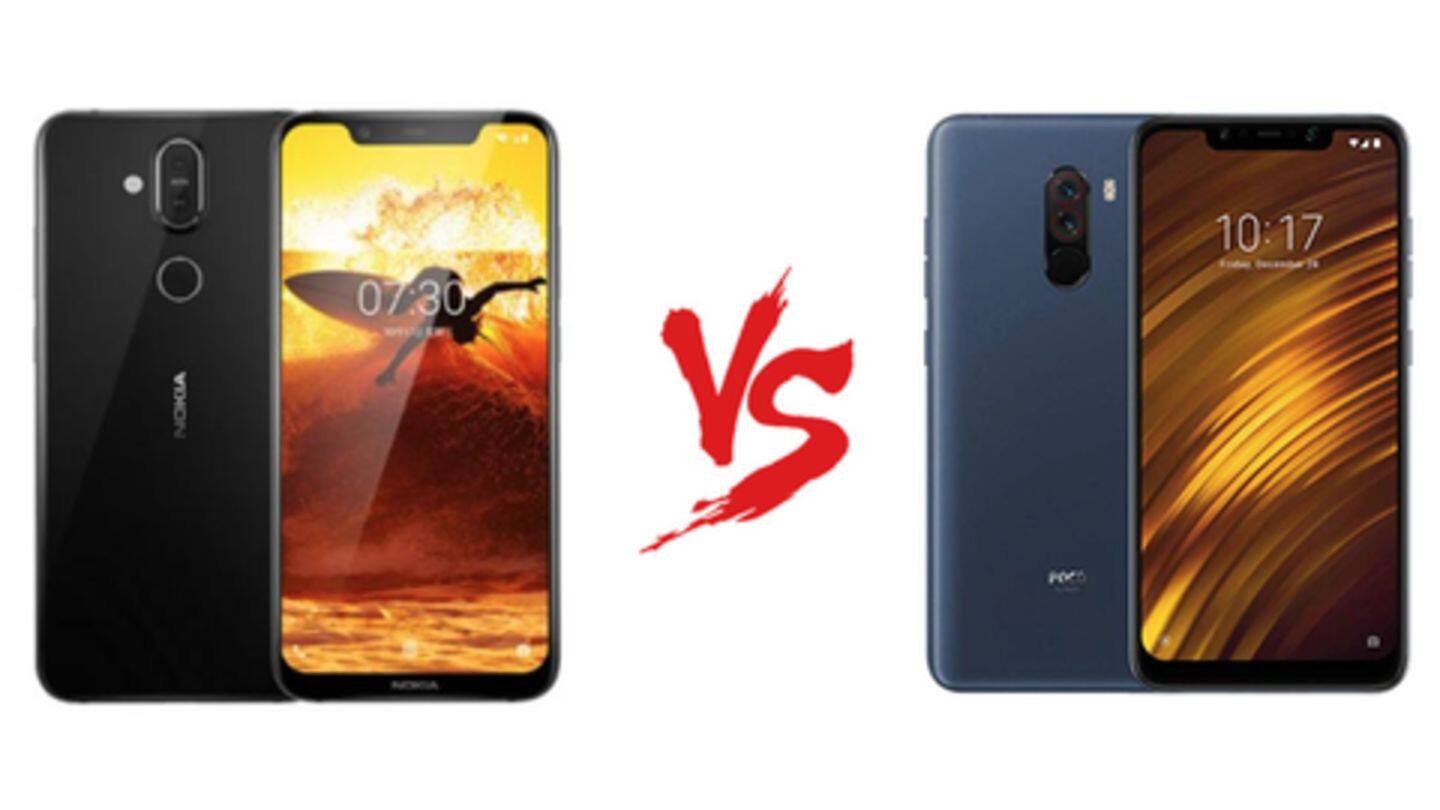
#SmartphonesFaceoff: Nokia 8.1 v/s Xiaomi Poco F1- Which is better?
What's the story
Yesterday, HMD Global had unveiled Nokia 8.1 (a rebranded version of Nokia X7) in Dubai and it is expected to be launched in India on December 10. According to a previous report, the phone is tipped to be priced at around Rs. 23,999 in India. And at this price tag, Nokia 8.1 will take on the popular Xiaomi Poco F1. Here's our head-to-head comparison.
Design
At a glance
Up front, both the phones look quite identical with a wider notch, edge-to-edge display, and a nearly identical bottom bezel. However, in terms of build quality, Nokia 8.1 gets a 6000-Series aluminum body and a glass back panel. In comparison, the Poco F1 settles for a polycarbonate frame and casing. Winner: Nokia 8.1 for the its premium build quality.
Display
All about the screen
The Xiaomi Poco F1 sports a 6.18-inch full-HD+ (2246x1080) display with 500-nits brightness, 403ppi pixel density, and is protected by a curved Gorilla Glass 3. On the other hand, the Nokia 8.1 sports a 6.18-inch (1080x2246 pixels) full-HD+ display with HDR10 support, 500 nits peak brightness and an 18.7:9 aspect ratio. Winner: Tie as both the phones support roughly the same screens.
Primary Camera
For the shutterbugs
Poco F1 features a rear dual-camera setup comprising a 12MP (f/1.9) Sony IMX363 sensor with dual-pixel autofocus, paired with a 5MP (f/2.0) secondary depth sensor. On the other hand, Nokia 8.1 sports a ZEISS optics-based dual camera setup with a 12MP (f/1.8) primary sensor with dual-pixel autofocus, and OIS, paired with a 13MP secondary sensor with fixed focus. Winner: Nokia 8.1 for better optics.
Selfie Camera
For the love of Selfies
Poco F1 comes with a 20MP (f/2.0) camera with support for AI-based Portrait mode and Scene detection with India-specific optimizations. In comparison, Nokia 8.1 also sports a 20MP selfie snapper with f/2.0 aperture, 1.8-micron pixels, fixed focus, and AI-powered image enhancing features. Winner: Tie as both the phones offer nearly the same camera optics.
Internals
All the important stuff
Poco F1 is powered by the Qualcomm Snapdragon 845 processor with dedicated LiquidCool Technology, paired with 6GB/8GB of RAM and 64GB/128GB/256GB of inbuilt storage (expandable up to 256GB). Nokia 8.1 runs on octa-core Qualcomm Snapdragon 710 processor, paired with 4GB of RAM and 64GB of internal storage (expandable upto 400GB). Winner: Poco F1 for packing high-end internals and flagship Snapdragon 845 chipset.
Sensors & Software
Lifeblood of your smartphone
Both the phones get a standard array of sensors including an accelerometer, ambient light sensor, e-compass, gyroscope, and rear-mounted fingerprint scanner. However, the Poco F1 also comes with an Infrared-based face unlock technology. Meanwhile, in terms of software, Nokia 8.1 has the advantage of Android One program which promises at least two years of software updates and offers stock Android Pie. Winner: You decide.
Battery & Connectivity
Staying connected
In terms of connectivity options, both the phones support dual-SIM cards, 4G VoLTE, Wi-Fi 802.11a/c, Bluetooth v5.0, GPS/A-GPS, a USB Type-C port, and a 3.5mm headphone jack. As far as battery is concerned, Nokia 8.1 packs a 3,500mAh battery with support for 18W fast charging whereas Poco F1 offers a 4,000mAh battery with support for Quick Charge 4.0. Winner: Poco F1 for bigger battery.
Information
Pricing: The key factor
The Poco F1 costs Rs. 20,999 for the base-end 6GB/64GB variant while the mid-variant with 6GB/128GB model costs Rs. 23,999, and the top-end 8GB/256GB option costs Rs. 28,999. In comparison, the Nokia 8.1 is expected to be priced at Rs. 23,999.
Our result
How things stack up!
The Nokia 8.1 is a well-made phone with premium design and mid-level internals. However, its pricing will be crucial. That said, around Rs. 20,000 price mark, Xiaomi Poco F1 is hard to beat. While the company has cut corners in terms of build quality, you still get a full-HD+ display, Snapdragon 845 chipset, 4,000mAh battery, and high-end internals. Winner: Poco F1, hands down.